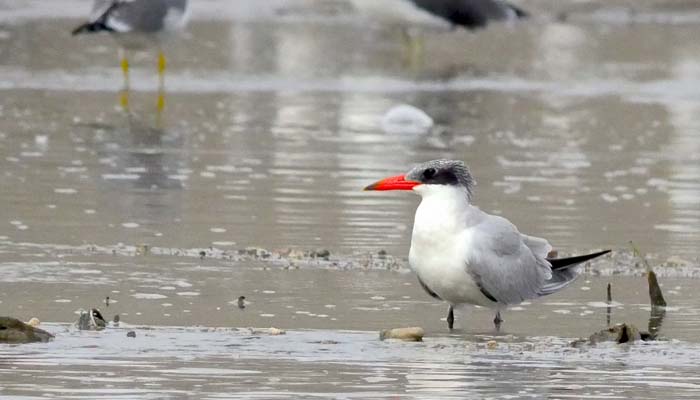
English: Caspian Tern
Russian: Чеграва
Mongolian: Морин шунгуулай, Морин хараалай
German: Raubseeschwalbe
French: Sterne caspienne
Japanese: オニアジサシ (Oni-ajisashi)
Body length: 48-55
cm.
Wing span: 96-111
cm.
Breeds
colonially or singly, mostly on more remote offshore, low islands. Summer
visitor (Apr-Oct; in Britain & Ireland about 5 records annually), winters
in W Africa, occasionally Mediterranean Sea. Migration partly over land,
following rivers over European continent, and crossing W Sahara in Mar and Nov.
Food mainly fish, which during breeding can be caught far from colony (30-60
km, or more), often in fresh water. Nest is bare scrape on ground (sand or
rocks).
Identification:
Largest tern; wingspan larger than Common Gull. Slow wingbeats and flight more
ponderous than other terns, is more gull-like; also, looks decidedly
front-heavy in flight. Very large red bill and extensive dark (blackish) under
primaries at all ages.
- Adult:
Bill bright red, with small dark subterminal mark on most; legs black. In
winter, black on head extensive, not thin-masked pattern of most other terns.
Juvenile: Full dark cap, extending further down on lores and cheeks than on
adult; dusky-tipped orange bill; pale legs; rather faint dark markings on
upperparts and tail; and inner wings rather uniformly pale, lacking obvious
dark carpal bars of other large terns.
- 1st winter: Orange-red bill (only
slightly paler than ad.winter) and dark legs develop quickly during first
autumn. Forehead usually becomes slightly paler, too (still streaked dark),
much as on adult winter.
- 1st summer: As adult winter, except wings and tail
much worn or with obvious variegated pattern through moult.